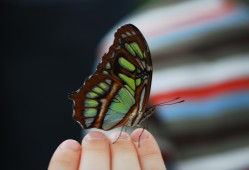The World of Butterflies:A Comprehensive Guide
- 百科大全
- 2025-06-25
- 34
Butterflies are a fascinating group of insects that have captured the imagination of people around the world for centuries. Known for their vibrant colors and elegant flight, these creatures are not just beautiful; they also play a crucial role in the ecosystem. This comprehensive guide delves into the world of butterflies, exploring their biology, behavior, and conservation efforts.
Introduction to Butterflies
Butterflies belong to the order Lepidoptera, which also includes moths. The name Lepidoptera is derived from the Greek words "lepido," meaning "scale," and "pteron," meaning "wing," referring to the scales that cover the wings of these insects. There are over 20,000 species of butterflies worldwide, with new species being discovered regularly.
Butterfly Anatomy
Butterflies are characterized by their large, often brightly colored wings, which are covered in tiny scales. These scales give butterflies their distinctive patterns and colors. The body of a butterfly consists of three main parts: the head, thorax, and abdomen. The head houses the compound eyes and antennae, which are used for sensing their environment. The thorax contains the wings and legs, while the abdomen houses the digestive and reproductive organs.
Metamorphosis

One of the most remarkable aspects of butterflies is their life cycle, which includes four distinct stages: egg, larva (caterpillar), pupa (chrysalis), and adult. This process is known as complete metamorphosis. The life cycle begins when a female butterfly lays her eggs on a host plant, which will provide food for the caterpillar once it hatches. The caterpillar then feeds voraciously, growing rapidly and shedding its skin multiple times. When it is ready, the caterpillar forms a chrysalis and undergoes a transformation, emerging as a fully formed adult butterfly.
Feeding Habits
Adult butterflies primarily feed on nectar from flowers, using their long, coiled proboscis to reach the sweet liquid. This feeding behavior is not only essential for their survival but also plays a vital role in pollination, as they transfer pollen from one flower to another. Caterpillars, on the other hand, are herbivores and feed exclusively on the leaves of their host plants.
Mating and Reproduction
Butterflies have a variety of mating rituals, which often involve the male using pheromones to attract a female. Once a female is receptive, the pair will mate, and the female will lay her eggs on a suitable host plant. The reproductive cycle is crucial for the continuation of butterfly species and the health of the ecosystems they inhabit.
Conservation Efforts
Sadly, many butterfly species are facing threats due to habitat loss, climate change, and the use of pesticides. Conservation efforts are vital to protect these delicate creatures. These efforts include habitat restoration, the creation of butterfly gardens that provide nectar-rich plants and host plants for caterpillars, and the reduction of pesticide use. Education and awareness about the importance of butterflies in the ecosystem also play a significant role in their conservation.
Cultural Significance
Butterflies have long been a symbol of transformation and rebirth in many cultures. They are often associated with the soul and are believed to carry messages from the spirit world. In art and literature, butterflies are used to represent change, hope, and the beauty of nature.
Conclusion
Butterflies are more than just beautiful creatures that grace our gardens and wild spaces. They are essential components of the ecosystem, contributing to pollination and serving as a food source for other animals. Understanding the world of butterflies is not only a journey into the natural sciences but also a celebration of the diversity and complexity of life on Earth. As we continue to learn more about these fascinating insects, it is our responsibility to protect and preserve their habitats for future generations to appreciate and study.
In conclusion, the world of butterflies is a rich tapestry of biology, behavior, and cultural significance. By studying and appreciating these creatures, we gain a deeper understanding of the natural world and our place within it. Let us continue to marvel at the beauty of butterflies and work together to ensure their survival for generations to come.













